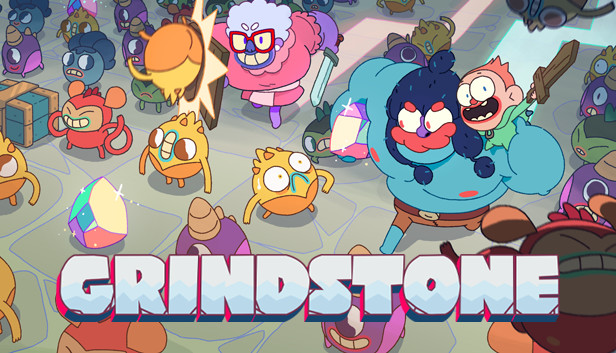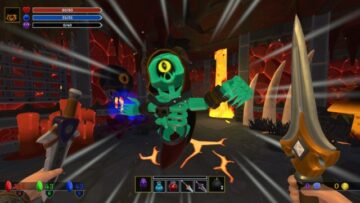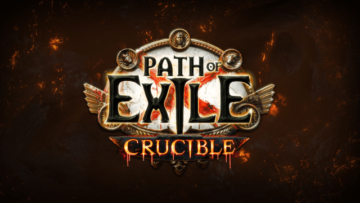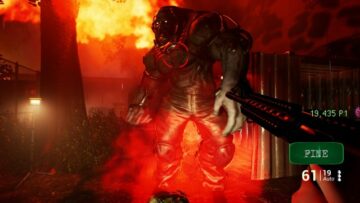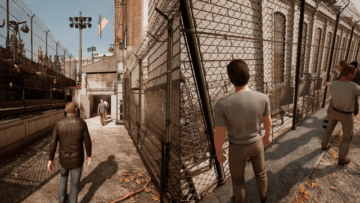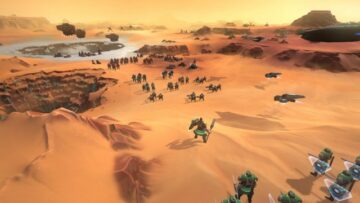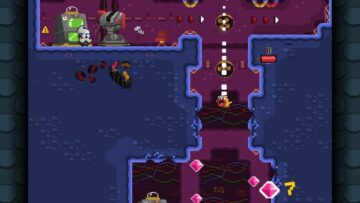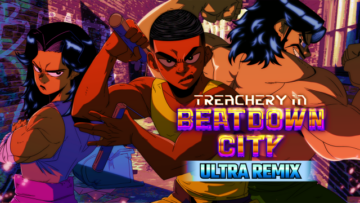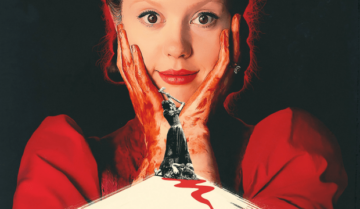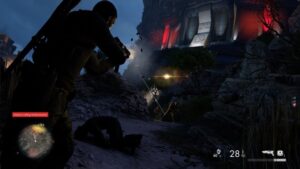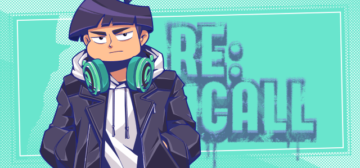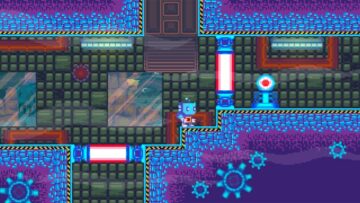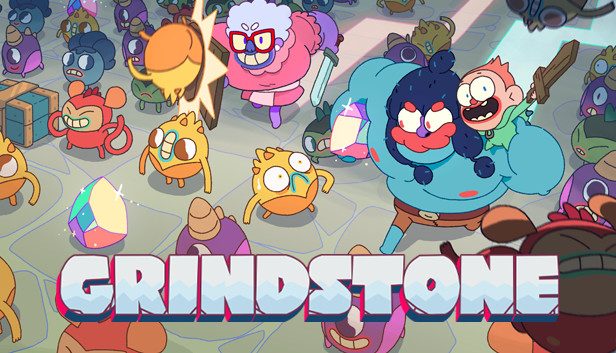
All reviews are cancelled! We’ve been stuck under Grindstone for the past week, and barely any work or reviews have been done. Forget that Redfall stuff: Grindstone is where the real gaming is at.
If you’re not aware of it, Grindstone is a bloody fantastic (in all senses) puzzle game, where you take the role of Jorj, a dungeon raider and grindstone gatherer, as he chains together similarly coloured ‘creeps’. If you’ve played Bejeweled or Puzzle Quest, you will have been in similar territory, but we can reassure you that none have looked or played like Grindstone.
We had to hold in all that gushing praise, for a moment, when we were offered the chance to interview Dan Vader, director of Grindstone at Capybara Games. Nobody likes a suck-up.
Hi, could you please introduce yourself and your role on Grindstone?
My name is Dan Vader and I’m Grindstone’s director.
Could you give us a quick overview of the game?
Grindstone is an action-puzzler that blends the kind of cozy, satisfying mechanics of colour-matching puzzle games with the visceral punch of more action-oriented, hack n’ slash games.
Colour-matching becomes combat: you’re lining up murderous paths of similar coloured lil’ monsters to dispatch them, but also to score resources and kills on stronger enemies and obstacles.
When I think of Grindstone, I think of the launch of Apple Arcade, as Grindstone was one of the first games to launch there. What was it like to be a flagship title on Apple Arcade? What did launching there give you that other platforms couldn’t?
I probably couldn’t understate the impact on Grindstone of being an Apple Arcade launch title. We really had no expectations of how Arcade would be received, we didn’t know what other kinds of games would be on offer, what the uptake would be etc. We were just elated to finally release this game we were so proud of. So it was almost shocking when the service launched and it got what seemed like an avalanche of press from literally all of the mainstream gaming media, and really just tons of mainstream media in general.
I don’t think mobile gaming has had as bright a spotlight shined on it since maybe when touch screen iPhone devices first hit the market. And then to have Grindstone featured so prominently in all that press, to have so many people noticing it and highlighting it among the catalog was incredibly gratifying. If we had’ve released the game as a premium title into the wider app store ecosystem I’m not sure it would’ve built the momentum it has.
In some ways we got incredibly lucky, kinda right place, right time, but ultimately having a fun-as-heck game is the only thing we can control no matter where we launch.
When you were designing Grindstone, was there a moment when you realised ‘we’ve got so much more than your traditional match-X puzzler here’?
Oh definitely! And with Grindstone I think it was much earlier in the process than usual.
Sometimes we have a core idea and it takes a lot of iteration to bring it to life and make it sing. You almost have to keep a flame of hope burning while you work to translate the idea from paper to engine. But Grindstone showed its fun and potential in almost the first prototype.
There was some kind of immediate alchemy that took place by smashing together “casual” colour matching puzzle gameplay with the idea of using it to “fight” stuff. And it was building on a foundation that Capy had already established with our other puzzle titles Critter Crunch and Clash of Heroes where the puzzle pieces themselves were little creatures and characters and the “board” is a little world bursting with detail. You could swap out all the art in Grindstone for just abstract coloured shapes and it would still play the same, but it wouldn’t connect the way it did.
I think the context we gave the mechanic helped, but also the flexibility of the mechanic itself. It’s not a Match-3 that has a more rigid ruleset, Grindstone with its diagonal pathing and twisty-turny, circuitous routes you can plot on the board feels like it’s more open to player experimentation. It’s a MatchMost!
What we love most about Grindstone is the flow. It’s the feeling that you can always find a better chain, a new way of getting a higher score, through grindstones and chaining through enemies – and then you watch Jorj chop through them all afterwards. How did you perfect this feeling of flow? Did it go through several iterations?
Absolutely! The core interaction: picking a path of like-coloured monsters and unleashing Jorj on a killing spree was never really in flux, but the elements that surrounded it took a lot of iteration to deliver the feel the game now has.
A lot of what we iterated on were the systems that supported the question: why do you want to hunt for that bigger, better chain? Early in the game’s development every single creep kill in the chain would spit out a gold coin. So you could do one big chain and get a lot of gold coins, or you could do a bunch of little short chains and essentially get the same amount. There was still the rule of spitting out a shiny Grindstone to allow for colour-switching i.e even bigger chains. But again, it felt like the game wasn’t telling you to reach for more achievement.
It was actually surprisingly late in the development that we decided to scrap the gold coin stuff and make grindstones the primary resource, and in fact to give you more valuable grindstones at each higher threshold of chain. Now the game was giving you clearer feedback on why you should create bigger and bigger chains!
Another element that seems so simple but took a little bit of time to arrive at is: the level goal. We tried it where when you satisfied the level goal it was smashcut to a score summary screen and you were “done”. But there was a big shift in the feeling of the game when we switched to requiring the player to actually path out the door to finish the level. Now we weren’t prescribing a shape to the experience. And naturally players stuck around in levels longer, their greed kicking in pushing them to keep trying to squeeze every grindstone out of a level they could. It became a real signature of the game.
Grindstone has thrived on touchscreen devices or those with a mouse. How has it been transitioning to a gamepad?
Ya, at first it was a little daunting to approach the idea of translating such a tactile touch experience to console gamepads. It was kind of the issue you see with games built for controllers arriving on mobile touch devices, but in reverse! A lot of those ports feel like something gets lost in translation.
With Grindstone there was a quality bar for the experience we weren’t willing to compromise on. We spent a lot of time on the gamepad controls to make them feel responsive, but not too loose that you mis-pick. The cursor needed to be responsive and yet have a weight to it so that every move translated the intentionality of the player. And we also built in some predictive directionality that took a bit to dial in.
Ultimately, Grindstone is a game where you can spend a lot of contemplative time drawing and re-drawing the perfect chain! I think we did a great job of transposing that experience to sitting on a couch with a controller in your hand. And holy moly does the game ever look great on a big TV!
Grindstone has evolved so much since we played on Apple Arcade, with a huge number of modes and additional dungeons. What have been the biggest steps on this journey?
By far the biggest step was Capy learning on-the-fly how to develop a “live” game. Again, we had very little foreknowledge of how Arcade would function in the marketplace, and actually we were a fairly late addition to their pre-launch roster. In our minds we had built a great game with 150 action-packed levels capped off with a fun little “ending” cutscene so the game was “done” and we were already kinda thinking “what do we work on next?” But very quickly after launch there was a clear demand for more content that got us thinking about how to serve the audience.
And then a little thing happened called the GLOBAL PANDEMIC and the whole friggin’ world was shut in their houses and demand for games, all games, seemed to explode. Grindstone was the same. Suddenly, with the whole studio remote, we had to pivot to a regular “live” cadence of content updates on a game we kinda built to be linear/finite. It was a huge learning curve, but an experience that I think was incredibly valuable for the studio. And we always knew that the core mechanic was so malleable and flexible that it could really support a lot of different expressions, and getting to make challenge modes, and remix levels and newgame+ kind of twists really proved that out.
We love the characters of Grindstone. Have you seen your community embracing them? Do you get people cosplaying as Jorj or Jorja?
Thank you! Ya Jorj and his family occupy a very prominent place in our hearts! I mean the reason this murdery, gut-splattered game is juxtaposed with a story about a parent just punching the clock and doing what he’s gotta do to support his family, is because many of us at the studio were starting our own families and wanted that reflected in our games.
We’ve seen a ton of beautiful and hilarious fan art for Grindstone but I don’t recall us seeing any cosplay yet… that would be a lot of blue body paint… But we’re still holding out hope we come across a Jorj or Jorja at a future event! That would make our day!
Is this the end for Grindstone support? Is console launch the endpoint, or a new beginning?
That’s a great question. It’s been an incredible, nearly 4 years of having the privilege of getting to continuously work on a game we all love so much! Again, we never planned it this way! Right now we’re just so happy to have Grindstone able to reach so many more players. If all these new console stonegrinders started to demand more, well we have a huge warchest of ideas…
What is next for Capybara Games? What can we expect from you?
We’re working on some pretty exciting, unannounced (sorry!) stuff at the moment. Again, the experience of Grindstone seemed to energize us and focus us around some things we think we do really well at the studio.
What does the grindstone thief do with all the stuff they steal?
Holy smokes great question! So Gladys, the thief, is a former stonegrinder just like Jorj. She just got fed up with the danger and grind of the job. She’s like the darker, flip side of the coin to Jorj. Screw working for loot I’ll just steal it! It’s all toil and struggle in the world of Grindstone so I imagine she takes her stolen loot and uses it to support her own family. If only Jorj could flip her back to the virtuous path…
Grindstone, you will be pleased to know, is out now, available from the Xbox Store. We slapped a 4.5 out of 5 on it in our review, and we can’t recommend it enough. If you have a taste for puzzle-RPG crossovers like Puzzle Quest and Gems of War then we would say Grindstone is the best of the bunch. Treat yourselves and pick it up – you’ll find it available on Xbox, PlayStation, Nintendo Switch, PC and Apple Arcade.
Huge thanks go out to Dan for giving us the chance to ask these questions.
- SEO Powered Content & PR Distribution. Get Amplified Today.
- PlatoAiStream. Web3 Data Intelligence. Knowledge Amplified. Access Here.
- Minting the Future w Adryenn Ashley. Access Here.
- Buy and Sell Shares in PRE-IPO Companies with PREIPO®. Access Here.
- Source: https://www.thexboxhub.com/exclusive_interview_capybara_games_grindstone/
- 1
- a
- able
- About
- ABSTRACT
- across
- ADDITION
- Additional
- after
- afterwards
- again
- AI
- Alchemy
- All
- allow
- already
- also
- always
- among
- amount
- an
- and
- any
- app
- Apple
- Apple Arcade
- approach
- Arcade
- ARE
- around
- Art
- as
- At
- audience
- available
- Avalanche
- back
- bar
- BE
- beautiful
- became
- because
- been
- beginning
- being
- BEST
- Better
- BIG
- bigger
- Biggest
- Bit
- Blue
- board
- body
- Bright
- bring
- Building
- built
- Bunch
- but
- by
- Cadence
- called
- CAN
- Capybara Games
- catalog
- chain
- chains
- challenge
- chance
- characters
- clear
- clearer
- Coin
- Coins
- combat
- come
- community
- compromise
- connect
- Console
- content
- context
- continuously
- Control
- controller
- Controllers
- controls
- Core
- Cosplay
- could
- create
- crunch
- curve
- Danger
- darker
- decided
- deliver
- Demand
- designing
- detail
- develop
- Development
- Devices
- DID
- different
- Director
- Dispatch
- do
- does
- doing
- done
- door
- Drawing
- e
- earlier
- Early
- ecosystem
- element
- elements
- embedded
- embracing
- end
- Endpoint
- engine
- enough
- Essentially
- established
- etc
- even
- EVER
- Every
- evolved
- Exciting
- Exclusive
- expect
- expectations
- experience
- families
- family
- far
- featured
- Fed
- feedback
- feel
- Finally
- find
- finish
- First
- flagship
- Flexibility
- flexible
- flow
- Focus
- For
- Former
- Foundation
- from
- fun
- function
- future
- game
- Gamepad
- gameplay
- Games
- Gaming
- General
- Get
- getting
- give
- Giving
- Global
- global pandemic
- go
- goal
- Gold
- great
- greed
- Grindstone
- hack
- had
- hand
- happened
- happy
- has
- Have
- having
- he
- helped
- her
- heroes
- higher
- highlighting
- hilarious
- his
- HIT
- hold
- holding
- hope
- houses
- How
- How To
- HTTPS
- huge
- i
- idea
- if
- imagine
- IMMEDIATE
- Impact
- in
- incredible
- incredibly
- interaction
- Interview
- into
- introduce
- iPhone
- Is
- issue
- IT
- iteration
- ITS
- itself
- Job
- journey
- jpg
- just
- keep
- Kills
- kind
- know
- late
- launch
- launched
- launching
- learning
- Level
- levels
- Life
- like
- Little
- longer
- Look
- looked
- lost
- lot
- love
- Mainstream
- mainstream media
- make
- many
- many people
- Market
- marketplace
- matter
- mean
- Mechanics
- Media
- minds
- Mobile
- Mobile gaming
- modes
- moment
- Momentum
- monsters
- more
- most
- move
- much
- name
- nearly
- needed
- never
- New
- Next
- Nintendo
- Nintendo Switch
- no
- Nose
- not
- now
- number
- obstacles
- of
- off
- offer
- offered
- on
- One
- only
- open
- or
- Other
- our
- out
- own
- pandemic
- Paper
- Past
- path
- PC
- People
- perfect
- pick
- picking
- Pivot
- place
- planned
- Platforms
- plato
- plato data intelligence
- platodata
- platogaming
- play
- player
- players
- playstation
- playstation 4
- playstation 5
- please
- pleased
- ports
- potential
- Premium
- press
- pretty
- primary
- privilege
- probably
- Process
- prominent
- Prototype
- proud
- proved
- punch
- pushing
- put
- Puzzle
- quality
- quest
- question
- questions
- quick
- quickly
- reach
- Real
- really
- reason
- reassure
- received
- recommend
- regular
- release
- released
- remote
- resource
- Resources
- responsive
- review
- Reviews
- right
- rigid
- role
- roster
- routes
- Rule
- same
- satisfying
- say
- score
- Screen
- see
- seeing
- seems
- seen
- Series
- serve
- Service
- several
- shape
- she
- shift
- Short
- should
- side
- similar
- Simple
- since
- single
- Sitting
- smokes
- So
- some
- something
- spend
- Spotlight
- Squeeze
- started
- Starting
- step
- Steps
- still
- stolen
- store
- Story
- stronger
- studio
- such
- summary
- support
- Supported
- swap
- Switch
- Systems
- Take
- takes
- taste
- territory
- than
- thanks
- that
- The
- The Game
- the world
- their
- Them
- themselves
- then
- there
- These
- they
- thing
- things
- think
- Thinking
- this
- those
- Through
- time
- Title
- titles
- to
- together
- Ton
- tons
- too
- took
- touch
- Touchscreen
- traditional
- trailer
- transitioning
- Translation
- treat
- tried
- twists
- ultimately
- under
- up
- Updates
- us
- using
- valuable
- very
- want
- war
- was
- Watch
- way
- ways
- we
- week
- well
- were
- What
- when
- where
- while
- whole
- why
- wider
- will
- willing
- with
- Work
- working
- world
- would
- xbox
- xbox series
- Xbox Series X|S
- years
- yet
- you
- your
- yourself
- youtube
- zephyrnet
